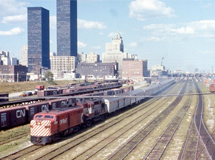 |
 |
|
| eNews • April 2013 | ||
| Promoting a Cost-Effective, Reliable and Competitive Transportation System |
||
 STC study promotes rail investment in rural America
STC study promotes rail investment in rural America
U.S. freight railroads are essential to the viability and profitability of the U.S. soybean industry. Most of the leading soybean producing states – even those with river access – significantly depend on the rail industry to satisfy customer demands. As more soybean production occurs in western states and as export terminals at Pacific Northwest ports increasingly position themselves to address growing demand from Asia, the dependence on rail will likely become more pronounced. Each year, over 900 million bushels (27.5 million tons) of U.S. soybeans are transported by rail. By the year 2020/2021, the volume moved by rail is estimated to increase to 1.4 billion bushels (42 million tons).
Rail is among the most capital intensive industries in the overall economy. It contrasts with other modes of transportation in the fact that it is privately financed and maintained. Billions of dollars are spent every year by freight railroads to augment and maintain their networks. However, despite this sizable investment, a recent study funded by the soybean checkoff estimates that a funding shortfall will likely occur between this planned investment and the future needs of the U.S. economy and the soybean industry. The study further highlights approaches that could be most effective in addressing this shortfall.
“When examining the U.S. soybean industry, there is considerable reason for optimism,” explains Pat Knouff, a soybean farmer from Minster, Ohio, and Chairman of the Soy Transportation Coalition. “Soybean farmers are increasingly productive. Our customers – both domestic and international – increasingly demand this production. However, we are concerned with our transportation infrastructure’s ability to connect supply and demand. Much of our soybean production occurs 1,000 – 1,500 miles from our nation’s ports. This requires us to transport a sizable volume of soybeans and soy products via the more efficient long haul modes, such as rail. Given the importance of the rail industry to the profitability of the soybean industry, we are concerned when acquainted with the prospect of a future investment shortfall.”
The study, “Agriculture and Railroads: Maintaining a Track Record of Success,” was performed by TRC Consulting. The analysis suggests that between 2012 and 2035 there will be an annual funding gap of $1.55 billion between expected investment by our nation’s railroads and the needs of the U.S. economy.
The study further examined various financial investment incentives that could help address this funding shortfall including: 1.) The Railroad Rehabilitation and Improvement Financing Program; 2.) An investment tax credit of 25 percent; 3.) Accelerated depreciation and “bonus” depreciation of 50 percent; and 4.) General business tax rate reduction of corporate taxes from 35 percent to 25 percent. That analysis concluded that the investment tax credit of 25 percent with accelerated depreciation produced the most incentive for rail investment.
“One of the reasons an investment tax credit for rail infrastructure is so attractive, is that the credit could be designed to benefit soybean and grain shippers – not only the rail companies,” says Mike Steenhoek, executive director of the Soy Transportation Coalition. “Given how constructing a single upgraded rail facility capable of loading large unit trains of soybeans and grain can cost a processor or cooperative $20 million, we gravitate toward those proposals like the tax credit that will result in making agriculture an attractive place for rail investment.”
The analysis documents that while the federal government would annually incur $981 million in lost tax revenues by instituting an investment tax credit with accelerated depreciation, the total economic benefit to the U.S. economy would be $2.3 billion per year, including $98 million of benefits to the soybean industry alone in the form of lower rail rates and higher speed handling.
“During this time of economic scarcity, our country is trying to determine the most cost effective way of enhancing the capacity of our transportation infrastructure,” Steenhoek explains. “We naturally want the biggest bang for our buck. Our report suggests that approaches exist that will result in a favorable cost/benefit analysis and will practice better stewardship of limited resources. Instituting a rail investment tax credit will result in an improved infrastructure for agriculture and the overall economy in a manner that acknowledges our nation’s limited resources.”
The full results of the study can be accessed at www.soytransportation.org or www.unitedsoybean.org.
Soy Transportation Coalition |
|
